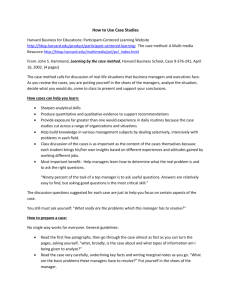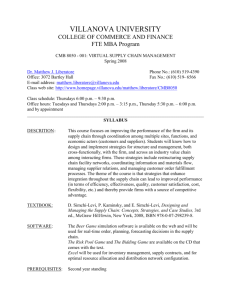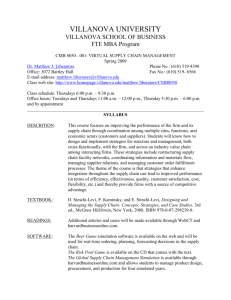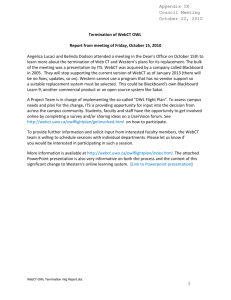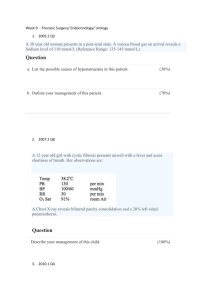C 75 - 70 - Villanova University
advertisement
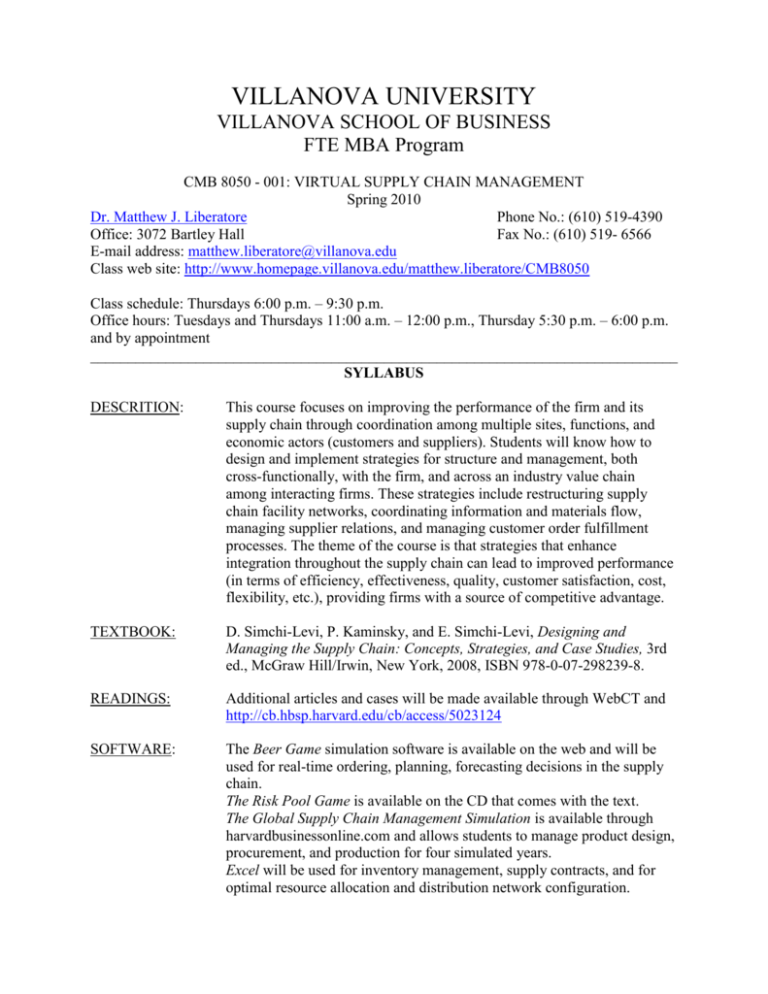
VILLANOVA UNIVERSITY VILLANOVA SCHOOL OF BUSINESS FTE MBA Program CMB 8050 - 001: VIRTUAL SUPPLY CHAIN MANAGEMENT Spring 2010 Dr. Matthew J. Liberatore Phone No.: (610) 519-4390 Office: 3072 Bartley Hall Fax No.: (610) 519- 6566 E-mail address: matthew.liberatore@villanova.edu Class web site: http://www.homepage.villanova.edu/matthew.liberatore/CMB8050 Class schedule: Thursdays 6:00 p.m. – 9:30 p.m. Office hours: Tuesdays and Thursdays 11:00 a.m. – 12:00 p.m., Thursday 5:30 p.m. – 6:00 p.m. and by appointment ______________________________________________________________________________ SYLLABUS DESCRITION: This course focuses on improving the performance of the firm and its supply chain through coordination among multiple sites, functions, and economic actors (customers and suppliers). Students will know how to design and implement strategies for structure and management, both cross-functionally, with the firm, and across an industry value chain among interacting firms. These strategies include restructuring supply chain facility networks, coordinating information and materials flow, managing supplier relations, and managing customer order fulfillment processes. The theme of the course is that strategies that enhance integration throughout the supply chain can lead to improved performance (in terms of efficiency, effectiveness, quality, customer satisfaction, cost, flexibility, etc.), providing firms with a source of competitive advantage. TEXTBOOK: D. Simchi-Levi, P. Kaminsky, and E. Simchi-Levi, Designing and Managing the Supply Chain: Concepts, Strategies, and Case Studies, 3rd ed., McGraw Hill/Irwin, New York, 2008, ISBN 978-0-07-298239-8. READINGS: Additional articles and cases will be made available through WebCT and http://cb.hbsp.harvard.edu/cb/access/5023124 SOFTWARE: The Beer Game simulation software is available on the web and will be used for real-time ordering, planning, forecasting decisions in the supply chain. The Risk Pool Game is available on the CD that comes with the text. The Global Supply Chain Management Simulation is available through harvardbusinessonline.com and allows students to manage product design, procurement, and production for four simulated years. Excel will be used for inventory management, supply contracts, and for optimal resource allocation and distribution network configuration. PREREQUISITES: Second year standing COURSE OBJECTIVES: 1. Recognize salient challenges and opportunities for managing supply chains. 2. Become familiar with supply chain strategies that have been adopted by leading companies. 3. Learn to use several analytical tools to assess tradeoffs and support decision making. METHOD: This course stress those models, concepts, and solutions methods that can be applied to the design, control, operation, and management of supply chain systems. The course includes lectures, case discussions, presentations, and hands-on, practical exercises and games to provide both a sound base of learning and an opportunity to test and develop skill. Students should do all of the assigned readings and cases before coming to class, and prepare for, and contribute to, class discussions. Excel is used to support the quantitatively intensive topics. STUDENT TEAMS: Teams will consist of about five students who will work together as the presenting and questioning teams for cases and articles as described below. The teams may allocate the work as desired, as long as all team members agree with the allocation. The team should let a member know if they are not performing at an appropriate level, and should contact the instructor if problems persist. Each team member will provide the instructor with an evaluation of their team members’ performance at the end of the term by allocating 100 total points (no self-allocation) between the other members. This information will be used to adjust team work grades. CASE PRESENTATIONS: Each student team will have the opportunity of serving as the “presenting team” for two of the cases and the “questioning team” for one of the cases that we will discuss in class. The “presenting team” will provide the background and content of the case, an analysis of what the company did correctly or incorrectly, and suggestions about what the company should do in the future. They should also address any questions given as part of the case write-up or indicated by the instructor. The “questioning team” will be responsible for questioning the presenting team, offering alternative solutions, and for leading the rest of the class in a discussion of the case. The questioning team will submit a written list of questions prior to the presentation. The members of the class will be asked to assess the performance of both teams. The instructor will incorporate the class evaluations into the presentation grades. 2 WRITTEN CASES: All students are individually required to submit three written case reports. The cases selected will be among those that a student is not participating as part of either the presenting or questioning team. The three reports will be selected from among the following cases: Sport Obermeyer Barilla SpA Zara H-P: Network Printer Design Contract Manufacturing Ethics Mattel Toy Recall These reports should be no more than six typed pages in length (double spaced, one inch margins, 12-point Times New Roman font). Proper grammar, spelling, and paragraph construction as well as evidence of effort in crafting a well-written analysis are required. Any questions listed in the case itself or on the class web site should be addressed within the report. Charts, tables and other graphical displays should be attached as an addendum, and do not count toward the page requirement. Please note that the sources used for written reports and presentations should be limited to the case itself and the material covered in this course. ARTICLE PRESENTATIONS: A series of supply chain management articles will be assigned as part of the class readings. Each student team will be assigned one article for class presentation. These presentations will cover the salient points in the articles, and the teams will address questions from the class. The members of the class will be asked to assess the performance of the presenting team. The instructor will incorporate the class evaluations into the presentation grade. OTHER ASSIGNMENTS: Graded problem assignments requiring the use of Excel will be made for the quantitatively oriented topics. Each student team must submit an Excel spreadsheet for each assigned problem that clearly indicates the suggested solution. All groups will submit the solution to one case. Other individual or group assignments may be given. EXAMINATION: The examination will consist of two parts: short answer/essay questions (closed book, with a sheet of notes allowed), and one or more problems requiring the use of Excel. Make-up examinations will only be given in cases of serious, documented emergencies or if permission is obtained from the professor PRIOR to the scheduled examination time. 3 FINAL CASE: All students will be required to individually submit a written report for a final case. The same submission format as mentioned above for the written cases will be followed. PARTICIPATION: Expectations for participation and involvement are high. You should come to class prepared to become involved in the discussion, and have read the specified material and prepared questions about areas that were not clear to you, and offer observations about other situations/examples that may help generate class discussion. The instructor will form a subjective impression of your performance. In addition, each class member is to provide the instructor with an evaluation of the performance of each their classmates using the following categories: 5 = exceptional participation that really contributed to my learning in the course; 4 = many solid contributions that helped the class to learn; 3 = solid participation that contributed to the discussion; 2 = sometimes contributed, but not at a high enough level; and 1 = this person did not pull their weight either in terms of the number or quality of contributions. Based on the aggregation of these reports, I will adjust the participation grade up or down. ATTENDANCE: Students are expected to make every effort to attend all classes. Missing more than one class during the semester will reduce your class participation grade. Students must be present when their team is presenting or questioning a case or presenting an article. Not being present will reduce the student’s grade for that assignment by 30 points. CELL PHONES AND WEB SURFING: It is important to display courtesy and respect towards others during class. Please turn off all cell phones prior to the start of class. Please do not surf the web, text message, or email during class. If you need to make or receive a call or if you feel you must surf the web, text message, or answer emails, please excuse yourself and leave the class room. ACADEMIC INTEGRITY POLICY: The Code of Academic Integrity of Villanova University addresses cheating, fabrication of submitted work, plagiarism, handing in work completed for another course without the instructor’s approval, and other forms of dishonesty. For the first offense, a student who violates the Code of Villanova University will receive 0 points for the assignment. The violation will be reported by the instructor to the Dean’s office and recorded in the student’s file. In addition, the student will be expected to complete an education program. For the second offense, the student will be dismissed from the University and the reason noted on the student’s official transcript. 4 DISABILITY: If you have a disability that may affect your success in this course and wish to discuss academic accommodations, please arrange to meet with me as soon as possible and not later than the end of the second week of the semester. GRADING: Case presentations and questioning, and article presentation Individual written cases Other written assignments Examination Final Case report Attendance and class participation Total 30% 25% 5% 15% 15% 10% 100% The assignment of grades based on the student’s weighted average numerical class grade: A AB+ B BC+ C F 100 - 93 92 - 90 89 - 87 86 - 83 82 - 80 79 - 76 75 - 70 69 - 5 TENTATIVE CLASS SCHEDULE No. 1 2 3 4 Date 1/14/10 1/21/10 1/28/10 2/4/10 Topic Class Introduction Readings Introduction to Supply Chain Management Ch. 1 Beer Game The Value of Information and the Bullwhip Effect App. A (internet version) Ch. 5 Article: Lee et al. (1997) – class discuss WebCT Case: Barilla SpA – G1 presents; G7 questions; G2, G3, & G4 hand in pp. 143 – 152 Class discuss: Meditech Surgical Case pp. 18 - 25 Article: Ellam et al. (2007) – G5 presents Inventory Management and Risk Pooling WebCT Ch. 2 Class exercise: Steel Works, Inc. Case pp. 27 – 30 & Steel Works spreadsheet (from CD) Swimsuit example pp. 36 – 41 & DMSC3e.xls (from CD); newsboy formulas Class discuss: Risk Pooling Case pp. 49 - 50 Risk Pool Game Forecasting App. B (student CD) Forecasting PowerPoint Class exercise: Wachovia Case Hardcopy Case: Sport Obermeyer – G2 presents; G4 questions; G1, G5, G6, & G7 hand in pp. 63 – 76 Network Planning Ch. 3 Class discuss: The Bis Corporation Case pp. 77 - 78 Class discuss: ElecComp Inc. Case pp. 97 – 102 Assigned problem: question 17 pp. 61 – 62 6 5 6 7 2/11/10 2/18/10 2/25/10 3/4/10 8 3/11/10 Network Planning with Mathematical Programming Ch. 3 and Math Programming PowerPoint Example 3.3 pp. 92 - 93 Lego Game and mathematical programming WebCT Assigned forecasting problems Supply Contracts class web page Ch. 4 Mini Case: American Tool Works: – G3 presents p. 123 – 124 Swimsuit example pp. 125 – 135 & DMSC3e.xls Class discuss: Reebok NFL Replica Jerseys – All groups hand in a solution pp. 172 – 177 Article: Nix et al. (2007) class discuss WebCT Assigned math programming problems Supply Chain Integration class web page Ch. 6 Mini Case: Dell Inc. Improving the Flexibility of the Desktop PC Supply Chain.: G7 presents pp. 179 – 187 Mini Case: The Great Inventory Correction: G1 presents pp. 204 – 207 Assigned problem: question 9 pp. 140 – 141 Presented case: Contract Manufacturing: Dealing with Supply Chain Ethical Challenges – G6 presents; G2 questions; G3, G4, & G5 hand in SPRING BREAK Procurement and Outsourcing Strategies http://cb.hbsp.harvard.edu/cb/access/502 3124 Presented case: Zara – G3 presents; G5 questions; G1, G2, G4, & G6 hand in pp. 267 - 280 Article: Ferdows et al. (2004) – G4 presents WebCT Article: Narayanan & Raman (2004) – class discuss Article: Pagell et al. (2007) – G7 presents WebCT 7 Ch. 9 WebCT 9 10 3/18/10 3/25/10 Distribution Strategies Ch. 7 Mini Case: Amazon.com’s European Distribution Strategy Case: G6 presents pp. 209 – 229 Strategic Alliances Ch. 8 Class discuss: How Kimberly-Clark Keeps Costco in Diapers Case pp. 243 – 246 Mini Case: Audio Duplication Services Case: G5 presents pp. 263 – 264 Article: Liker & Choi (2004) – G2 presents Global Logistics and Risk Management WebCT Ch. 10 Mini Case: Wal-Mart Changes Tactics to Meet International Tastes – G4 presents pp. 309 - 312 Article: Kahn (2004) – class discuss WebCT Article: Stauffer (2003) – class discuss WebCT Case: Unsafe for Children: Matell’s Toy Recalls and Supply Chain Management – G5 presents; G3 questions ; G1, G2, G6, & G7 hand in http://cb.hbsp.harvard.edu/cb/access/502 3124 Article: Zamiska et al. (2007) – class discuss 11 4/1/10 EASTER BREAK 4/8/10 Tentative Outside Speaker: Air Products Coordinating Product and Supply Chain Design WebCT SCOR Model; pp. 380 – 383 & WebCT Ch. 11 Class discuss: H-P Desk Jet Printer Supply Chain Case pp. 331 - 337 Article: Fisher (1997) – G3 presents WebCT Case: H-P Network Printer Design – G4 presents; G1 questions, G3, G5 & G7 hand in pp. 358 – 363 Article: Kahn (2003) -- class discuss pp. 365 – 367 8 12 4/15/10 EXAMINATION 13 4/22/10 Customer Value Ch. 12 Article: Ross (2006) – G6 presents WebCT Article: Lee (2004) – G1 presents WebCT Smart Pricing Ch. 13 Revenue management: ex. 13. 4 pp. 393 - 396 Mini Case: The Great Rebate Turnaround: Design – G2 presents pp. 402 – 404 Global Supply Chain Management Simulation – begin round 1 in-class, round 2 assigned Preparation for the game: review Sport Obermeyer case read Fisher et al. (1994) (not discussed in class) link to be provided 14 15 4/29/10 5/6/10 pp. 63 - 76 text http://cb.hbsp.harvard.edu/cb/access/502 3124 Putting It All Together Tentative Outside Speaker: Pfizer Ch. 14 Case: McDonald’s Corporation: Managing a Sustainable Supply Chain – G7 presents; G6 questions http://cb.hbsp.harvard.edu/cb/access/502 3124 Class discuss: Crocs: Revolutionizing an Industry’s Supply Chain for Competitive Advantage http://cb.hbsp.harvard.edu/cb/access/502 3124 Global Supply Chain Management Simulation – results FINAL CASE 9 READINGS: Ellram, L, Tate, W., and Billington, C., “Services Supply Management: The Next Frontier for Improved Organizational Performance,” California Management Review, 49(4), 2007, 44 – 66. Ferdows, K., Lewis, M. A., and Machura, J. A. D., “Rapid-Fire Fulfillment,” Harvard Business Review, November 2004, 104 - 109. Fisher, M. L., “What is the Right Supply Chain for Your Product?” Harvard Business Review, March – April 1997, 105 – 117. Fisher, M., J. Hammond, W. Obermeyer, and A. Raman, “Making Supply Meet Demand in an Uncertain World,” Harvard Business Review, May-June 1994, 83-92. Kahn, G., “Made to Measure: Invisible Supplier Has Penney’s Shirts All Buttoned Up,” Wall Street Journal, September 11, 2003, A1. Kahn, G., “Style & Substance: Tiger’s New Threads,” Wall Street Journal, March 26, 2004, B1. Lee, H. L., “The Triple A Supply Chain,” Harvard Business Review, October 2004, 102 – 111. Lee, H., P. Padmanabhan, and S. Wang, “The Bullwhip Effect in Supply Chains,” Sloan Management Review, Spring 1997, 93 – 102. Liker, J. K., and Choi, T. Y., “Building Deep Supplier Relationships,” Harvard Business Review, November 2004, 104 – 113. Narayanan, V.G., and Raman, A., “Aligning Incentives in Supply Chain,” Harvard Business Review, November 2004, 94 – 101. Nix, N. W., Lusch, R. L., Zacharias, Z. G., and Bridges, W., “The Hand That Feeds You,” Wall Street Journal, October 27, 2007, R8. Pagell, M., Wu, Z., and Murthy, N., “The Supply Chain Implications of Recycling,” Business Horizons, 50, 2007, 133 – 143. Ross, D., “The Intimate Supply Chain,” Supply Chain Management Review, July-August 2006, 50 - 57. Stauffer, D., “Risk: The Weak Link in Your Supply Chain”, Harvard Management Update, Harvard Business School Publishing, Boston, 2003. Zamiska, N., and Kesmodel, D., “Growing Concern: Tainted Ginger's Long Trip from China to U.S. Stores,” Wall Street Journal, November 19, 2007, A1. 10
